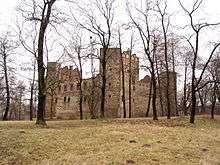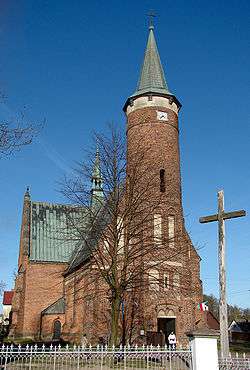Drzewica
| Drzewica | ||
|---|---|---|
|
Saint Lucas Church | ||
| ||
 Drzewica | ||
| Coordinates: 51°26′49″N 20°28′19″E / 51.44694°N 20.47194°E | ||
| Country |
| |
| Voivodeship | Łódź | |
| County | Opoczno | |
| Gmina | Drzewica | |
| Government | ||
| • Mayor | Janusz Bernard Reszelewski | |
| Area | ||
| • Total | 4.9 km2 (1.9 sq mi) | |
| Population (2006) | ||
| • Total | 3,945 | |
| • Density | 810/km2 (2,100/sq mi) | |
| Time zone | CET (UTC+1) | |
| • Summer (DST) | CEST (UTC+2) | |
| Postal code | 26-340 | |
| Car plates | EOP | |
| Website | http://www.drzewica.pl | |
Drzewica [dʐɛˈvʲit͡sa] is a town in Opoczno County, Łódź Voivodeship, Poland, with 4,022 inhabitants (2004). Located on the Drzewiczka river (a tributary to the Pilica), in northwestern corner of historic province of Lesser Poland, Drzewica is home to Gerlach, a renowned cutlery manufacturer, founded in 1760 in Warsaw (since 1886 in Drzewica). In the first half of the 16th century, the Archbishop of Gniezno and Primate of Poland Maciej Drzewicki built here a rectangular-shaped castle, surrounded by a moat. The castle burned in 1814 and now is a well-preserved ruin.

The town of Drzewica dates back to the 13th century, when prince Konrad I of Masovia granted the area to the Drzewicki (Ciołek coat of arms) family. The family owned Drzewica for 500 years, and its properties stretched from the Pilica to the Holy Cross Mountains. In 1429 in Nieszawa, Drzewica was incorporated as a town on German town law, by King Jogaila. Drzewica, which belonged to Opoczno County of Lesser Poland’s Sandomierz Voivodeship, prospered in the early 16th century, when its owner Maciej Drzewicki (1467 – 1535) was a personal secretary of King John I Albert. Drzewicki renovated the ancient castle, turning it from a Gothic stronghold into a Renaissance residence. Good times came to the end in 1655, when Swedish Army burned it to the ground (see Deluge (history)).
In the 18th century Drzewica became one of early centers of Polish industry, when one of the first Polish blast furnaces was built here by Filip Szaniawski. Soon afterwards, northern Lesser Poland became industrialized (see Old-Polish Industrial Region). After the Partitions of Poland, Drzewica was annexed by the Russian Empire (1815), together with Congress Poland. The town was an important center of the January Uprising, and as a revenge, in 1869, Tsarist authorities reduced it to the status of a village. On September 8, 1939, a nearby forest was the place of a bloody skirmish between Polish Army and the Wehrmacht. In 1942, Germans opened a ghetto for local Jews, most of whom perished in the Holocaust.
External links
Coordinates: 51°27′N 20°28′E / 51.450°N 20.467°E

